With Manchester City Women and Chelsea Women facing off against each other at the Academy Stadium last week, fans of the WSL may think that all of the action is happening at the top. However, the fight to stay in the top flight is also heating up week-by-week, with four teams all scrapping to avoid the drop. Saturday saw two of them meet, with Aston Villa Women hosting Bristol City Women at the Banks’ Stadium, home of EFL side Walsall. Both clubs are under temporary management, with experienced coach Matt Beard leading Bristol whilst Tanya Oxtoby is on maternity leave, and Aston Villa have former Grimsby Town manager Marcus Bignot in interim charge.
This tactical analysis will look at the tactics both sides played with, as well as the changes Bristol made after half-time to turn a poor performance into one which gave them something to build on in their last two games.
Lineups
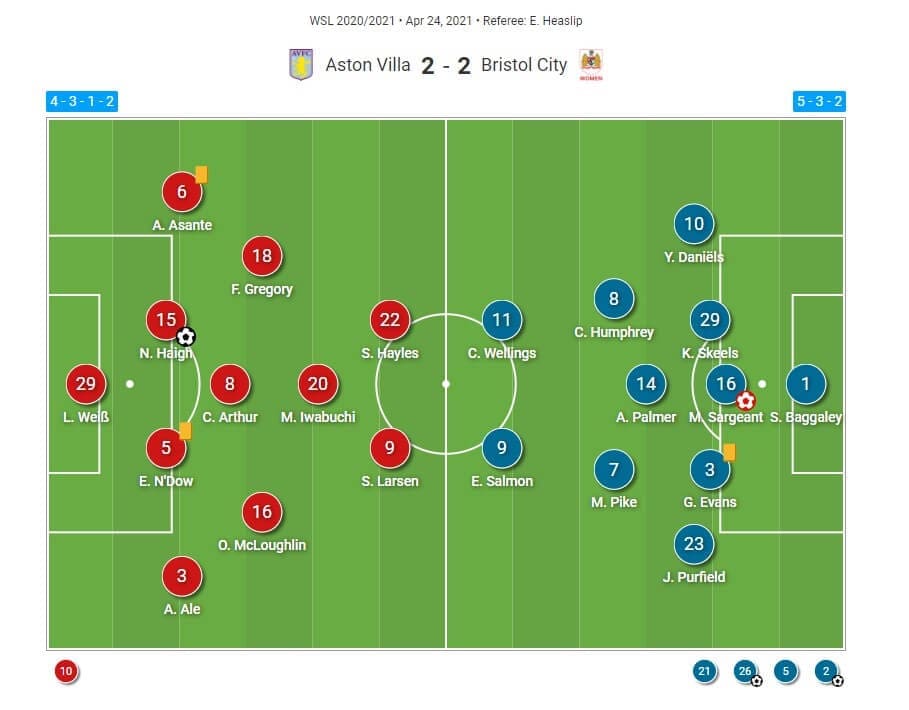
Aston Villa Women made three changes from their goalless draw at fellow strugglers West Ham United Women on Tuesday, going from a 3-5-2 to a 4-3-1-2 formation. Defender Jodie Hutton was left out of the matchday squad altogether, whilst right wing-back Ella Franklin-Fraiture and midfielder Amy West dropped to the bench. Asmita Ale moved across the pitch to right-back, whilst experienced defender Anita Asante came in at left-back. Exciting 16-year-old midfielder Olivia McLoughlin played alongside Scotland international Chloe Arthur and another young player, Freya Gregory, who moved back to the midfield from a forward role. Shania Hayles also came off the bench to start in attack, playing alongside Denmark striker Stine Larsen.
Bristol City Women made no changes from their FA Cup defeat to Brighton and Hove Albion Women last weekend, staying with the wing-back formation they have frequently used under Matt Beard. Belgium international Yana Daniels and Jemma Purfield, both formerly of Liverpool Women, started at wing-back, whilst Carla Humphrey, Aimee Palmer and on-loan Everton Women midfielder Molly Pike played together in midfield. The team’s two main forwards, England international Ebony Salmon and Charlie Wellings, partnered each other upfront once again.
Aston Villa Women’s attacking tactics
Aston Villa Women have a very distinct way of attacking, which we have become used to seeing from them this season. In the image below, we see how they generally set up in the final third.
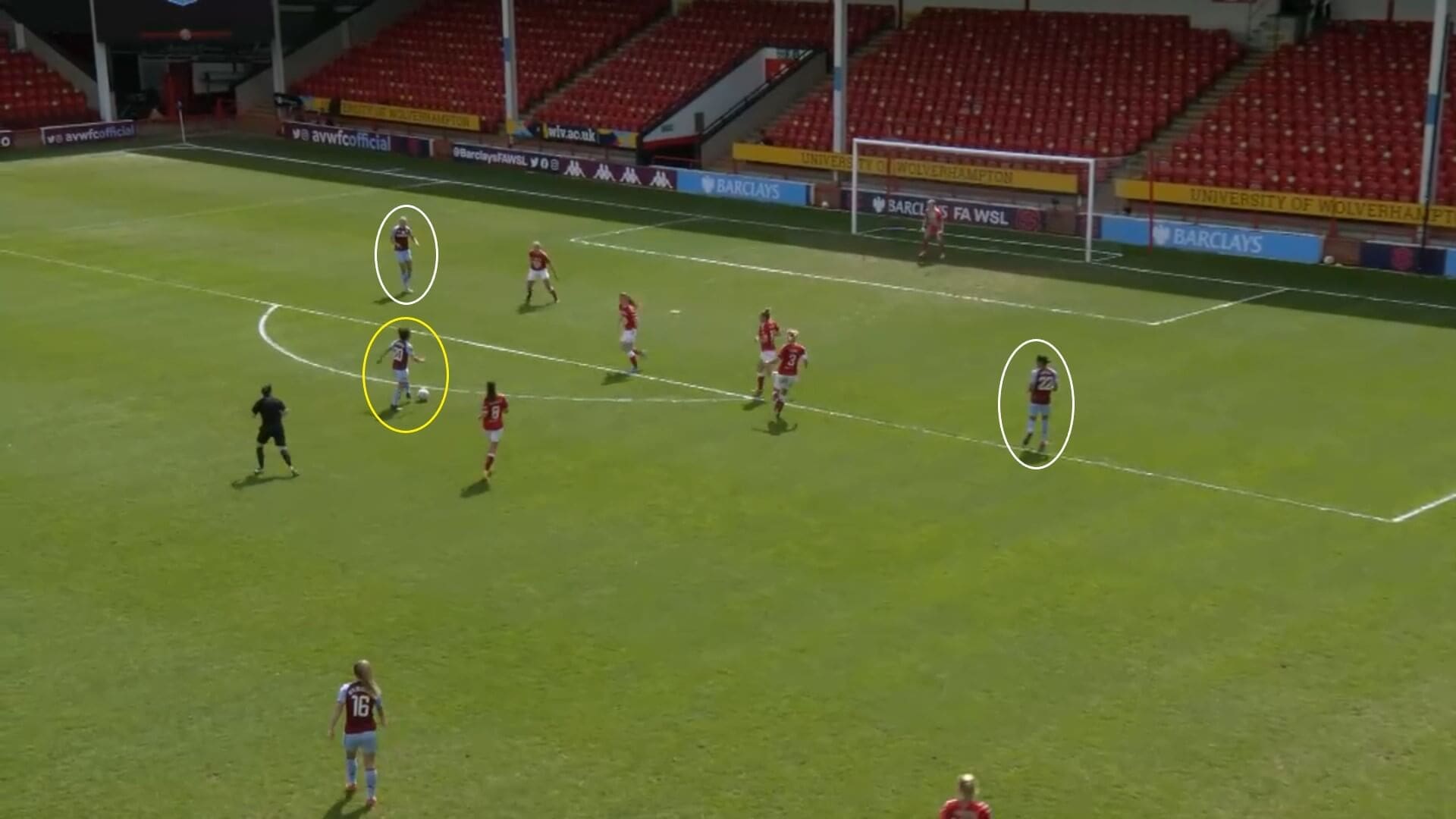
Their two strikers tend to drift out wide, playing either side of the opposing defence and isolating it, as Stine Larsen and Shania Hayles are doing here. However, until January, what had been missing was the player in the pivot role, who could move the ball into dangerous areas and link up the rest of the attack.
Japan international Mana Iwabuchi, in the yellow circle here, has filled this role since her arrival, constantly getting into pockets of space behind the two main strikers. It was interesting that, no matter who had the ball for the home side, their first thought was always to drive into the middle of the pitch, before then playing the ball to wherever the best option was. With two passing options available in this situation, Aston Villa could create a chance on either side of the box, or, if Bristol City Women’s defence split to cover both strikers, Iwabuchi could shoot through the middle.
However, whilst they have created plenty of chances in these areas of the pitch, they have lacked quality with the finish, having only scored 14 goals in the WSL this season; the joint-lowest (with Birmingham City Women), and this is why they are where they are in the table.
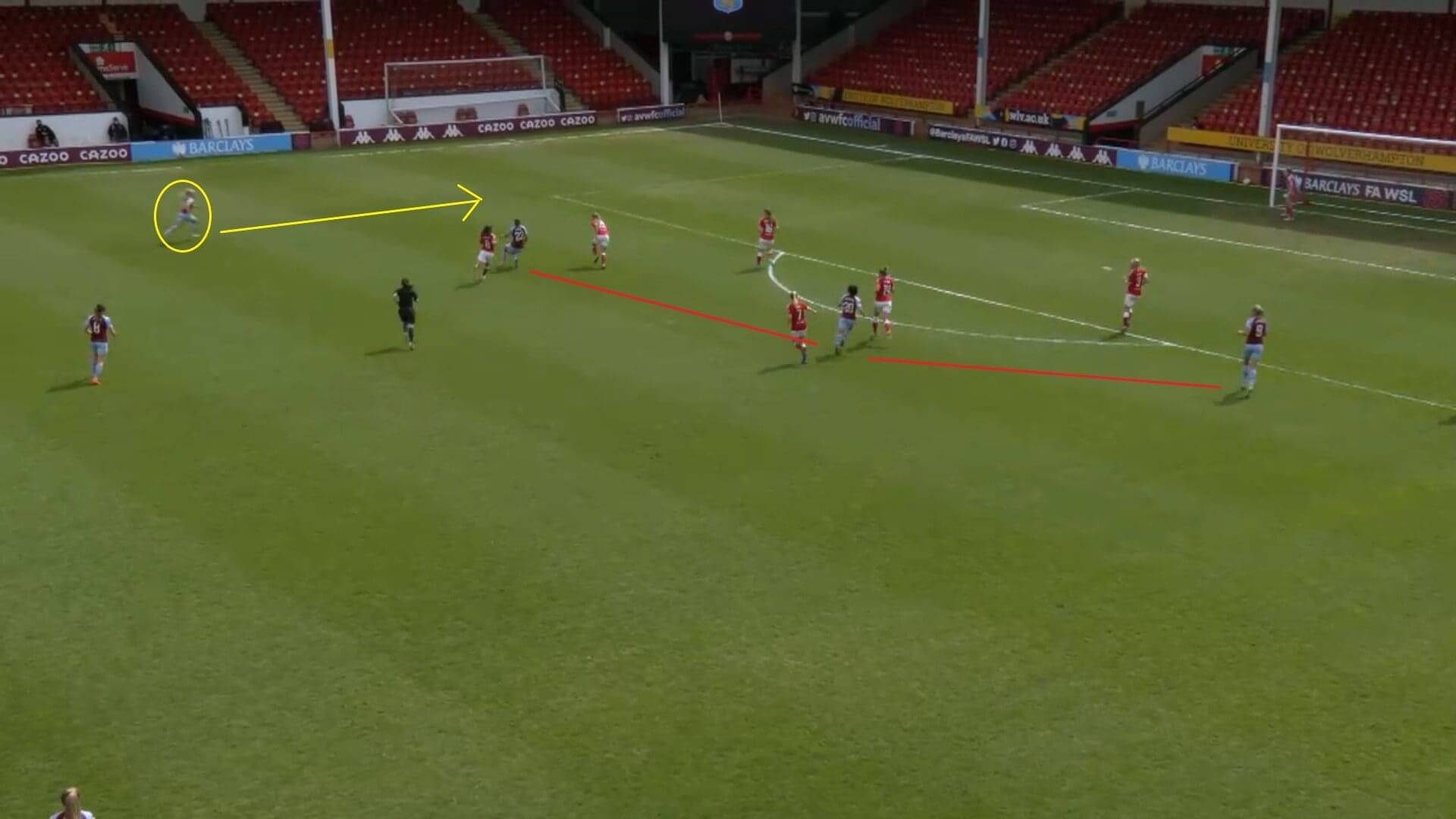
What adds an extra layer to their attack is the role of the wingers, or wide midfielders, depending on what formation they play with. We can see here how Bristol’s defenders are all concentrated around the three forwards, meaning that there is no way through for them to attack the space behind.
However, Freya Gregory is making a run through on the far side wing, providing Aston Villa with another route into the box. Gregory’s pace and versatility in the final third has proven to be a key weapon for her team in recent weeks, and her crosses into the box were constant in this game, meaning her teammates had good opportunities to score. Bristol struggled to cope with Aston Villa’s relentless attacking play in the first half, with moments like this showing the home side’s dominance.
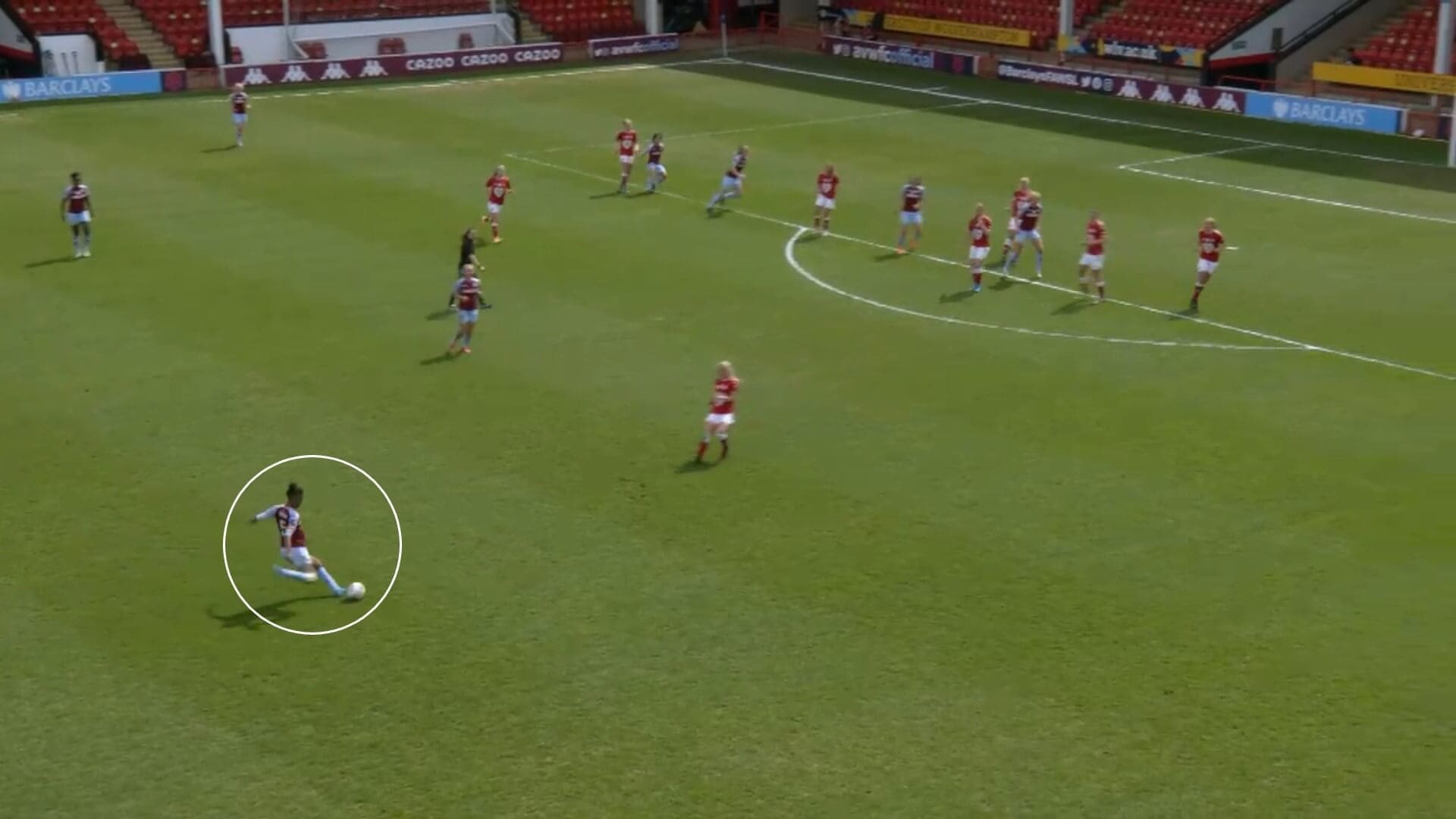
A lot of Aston Villa’s play came down the right-hand side of the pitch, with right-back Asmita Ale linking up well with teammates to set up opportunities in the middle. However, it was interesting that Aston Villa were using different players and different parts of the pitch to get the ball into the box, ensuring Bristol were under constant pressure at the back, never knowing for sure where the next ball would come from.
Here, centre-back Elisha N’Dow has advanced forward, having found space in Bristol’s half of the pitch to dribble into. Her cross into the box finds her central defensive partner Natalie Haigh, who heads across the box for Aston Villa’s second goal, putting the hosts in complete control of the game. This was another example of Aston Villa’s tactics giving them the advantage in the first half.
However, despite all of this, Aston Villa seemed to down tools in the second half, with Bristol coming out of the blocks stronger. As a result, the home side didn’t attack as often after half-time, as they tried to see the game out instead.
Bristol City Women’s first half play
Before we look at how Bristol City Women improved in the second half, we need to analyse their first half performance.
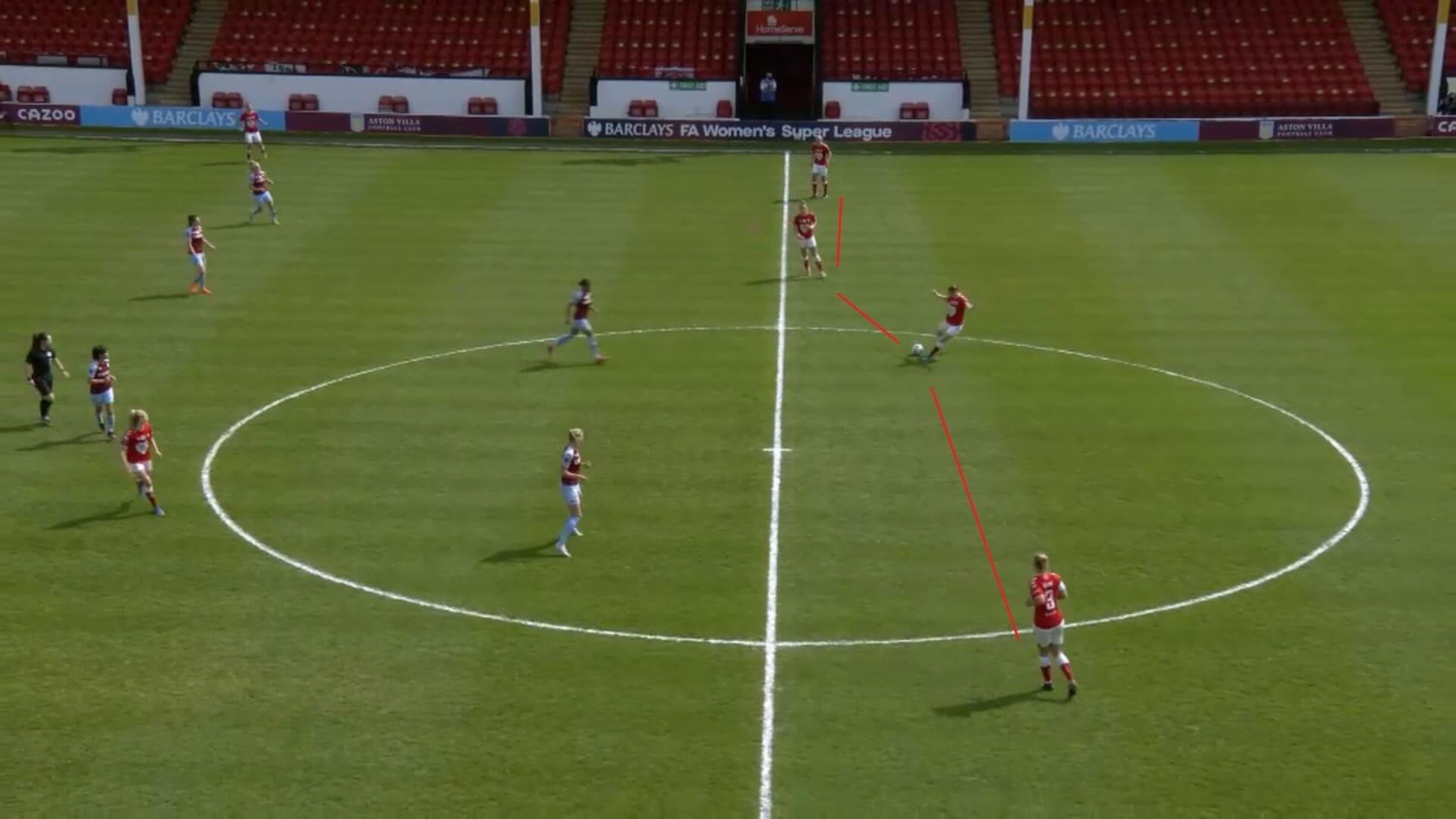
Bristol looked to play a very attacking game in the early stages of the match, with their defence moving up the field together, but staying in line, which was important. Their positioning ensured that Bristol’s midfielders and attackers could move higher up the pitch, increasing their attacking presence, and decreasing the distance that the ball had to travel to reach them from the defenders. Therefore, it was clear from this that Bristol had come to Aston Villa Women to win, and not to simply play out a draw.
From Aston Villa’s point of view, this squeezed them into their own half, making it hard for them to break out and launch an attack. This is because Bristol’s flat back line ensured that there was little space to run through, and, even if they did, there would be no support for them.
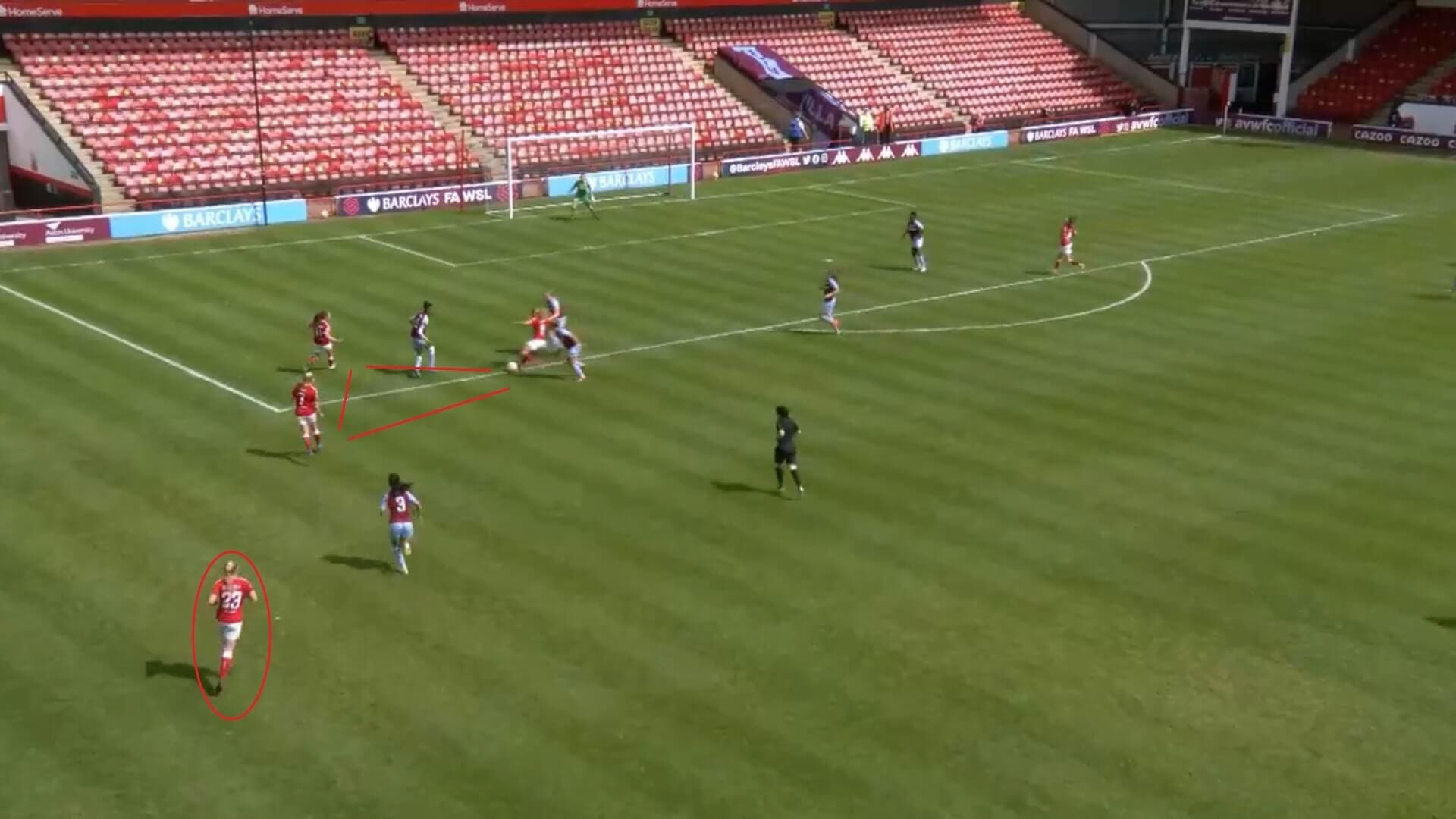
This image shows how Bristol looked to use their midfielders and forwards together, finding small pockets of space and creating opportunities to score. The three midfielders, Pike, Humphrey and Palmer, all played in the central areas, not worrying about covering the wings. This is because the two wing-backs, Purfield and Daniels, constantly advanced up the pitch to support the attack, looking to get in behind Aston Villa’s full-backs at every opportunity.
You can see here how Purfield has offered herself as a passing option if her team need her, and her positioning has allowed Pike to move infield and work with Wellings and Salmon in this triangular shape, giving Bristol a way of moving the ball around and trying to create a gap in Aston Villa’s defence.
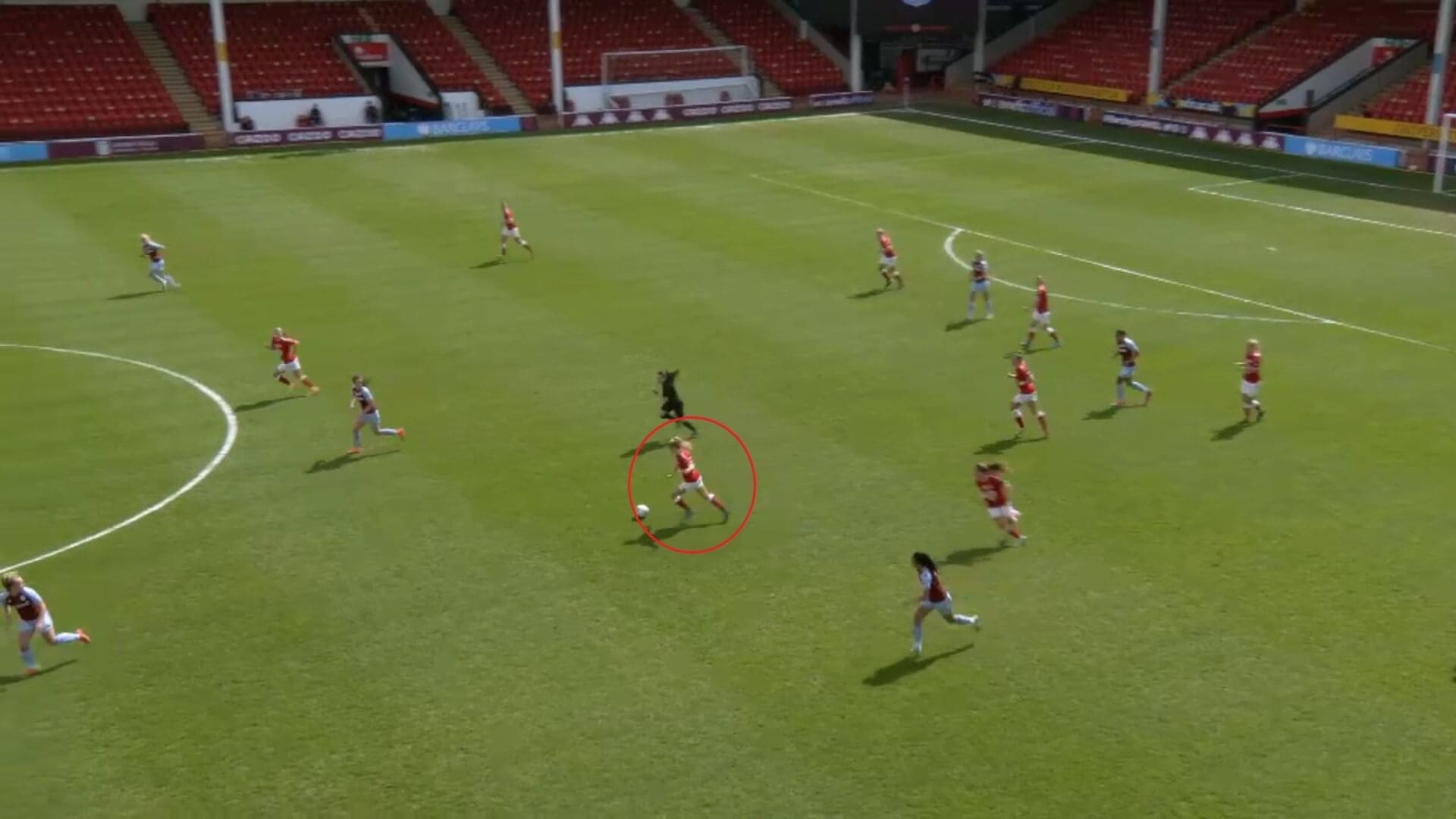
Bristol generally play long balls up the pitch in defence-to-attack transitions, and this is not something they have lost since Matt Beard came in. The reason for the long balls is because they always look to get the ball to Ebony Salmon as quickly as possible, allowing her to attack with as little opposing pressure as possible. In this game, it was particularly useful to have this tactic in their locker, with Aston Villa’s full-backs getting up the pitch to support their attacks, so there was space available in the final third, and an extra forward in Wellings to aim for. They didn’t make these aerial passes constantly, but they did help them to create a few good opportunities.
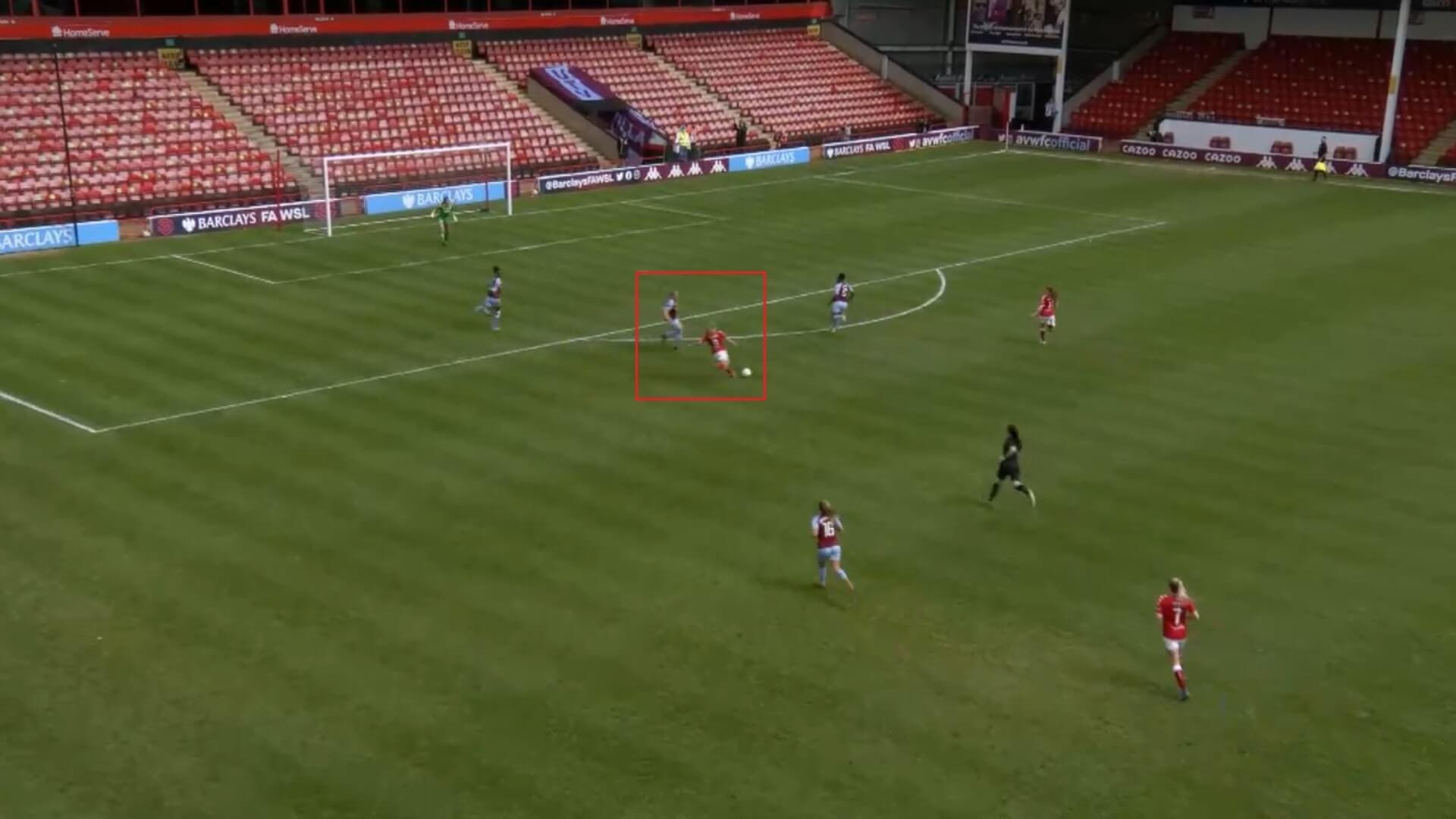
Matt Beard said after the game that he raised his voice in the dressing-room at half-time, having been very unimpressed with their performance up to that point. This was because they made a lot of unforced errors in possession, such as passes being too heavy or the ball going back to Aston Villa too easily, as well as the two goals that could have been prevented. They also wasted several good opportunities to score, such as here, with Salmon in possession and Wellings alongside her, but the former’s shot is blocked by Haigh. These continual errors were what they needed to address at half-time.
Bristol City Women’s second half changes
It was clear in the second half that Bristol City Women had more energy and desire, especially as they had nothing to lose at this point; they needed to get on the front foot and chase the game, because, as Beard had said beforehand, losing this match was not an option.
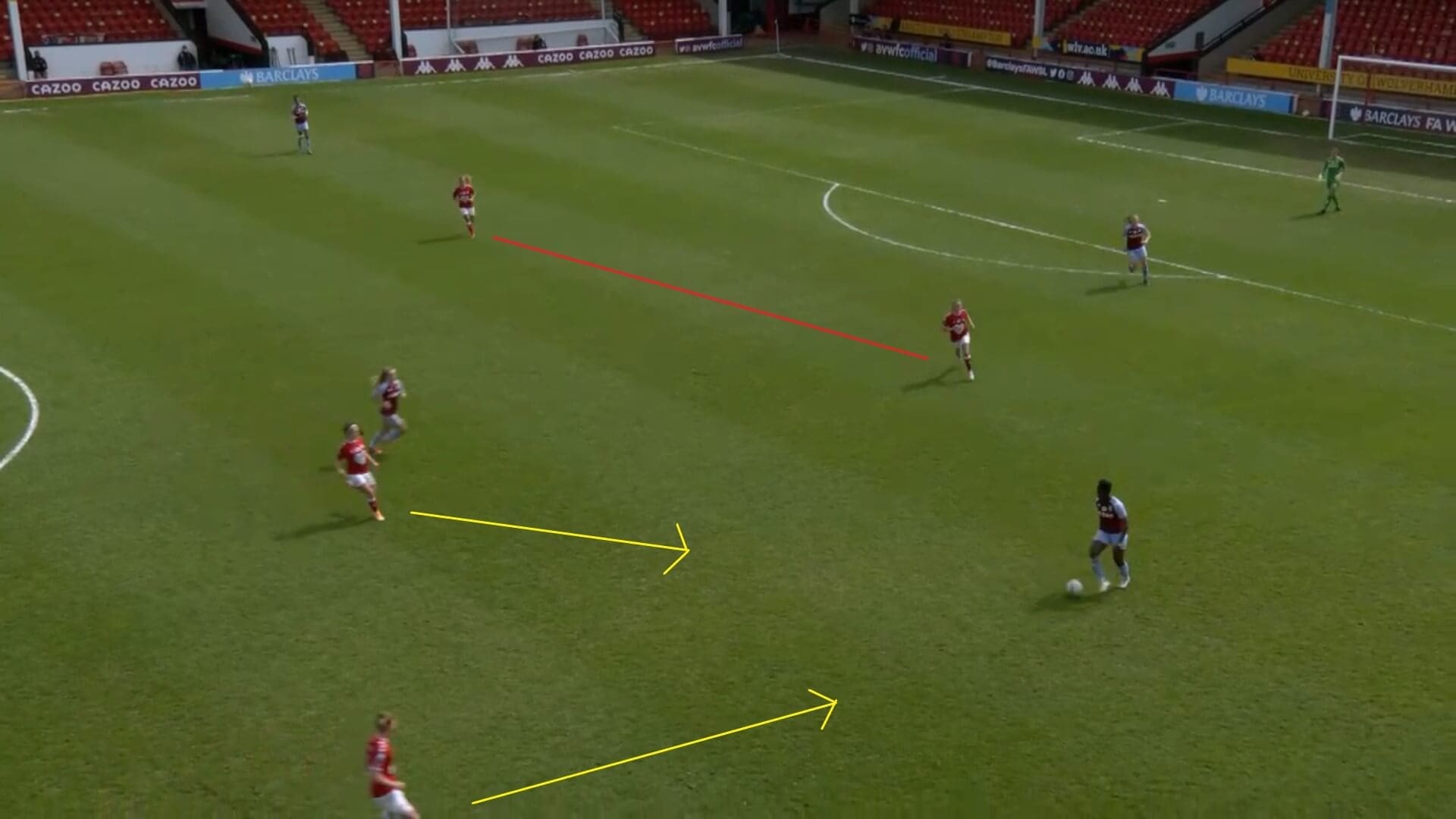
Here, we see how Aston Villa Women have the ball in their own half, but are under increasing pressure to move it quicker. Salmon and Wellings have worked together to press the home side’s centre-backs, forcing them to pass to Asante on the left side of the pitch. However, once Asante gets the ball, she is also closed down by two more Bristol players, as the yellow arrows indicate. This was a major change for Bristol, with added intensity to their play, and Aston Villa found it harder to advance forwards in the second half, resorting to more horizontal passes instead. This was what Bristol needed to have done more of in the first half, as it might have prevented their opponents from attacking so high up the pitch and getting the ball into the box so often.
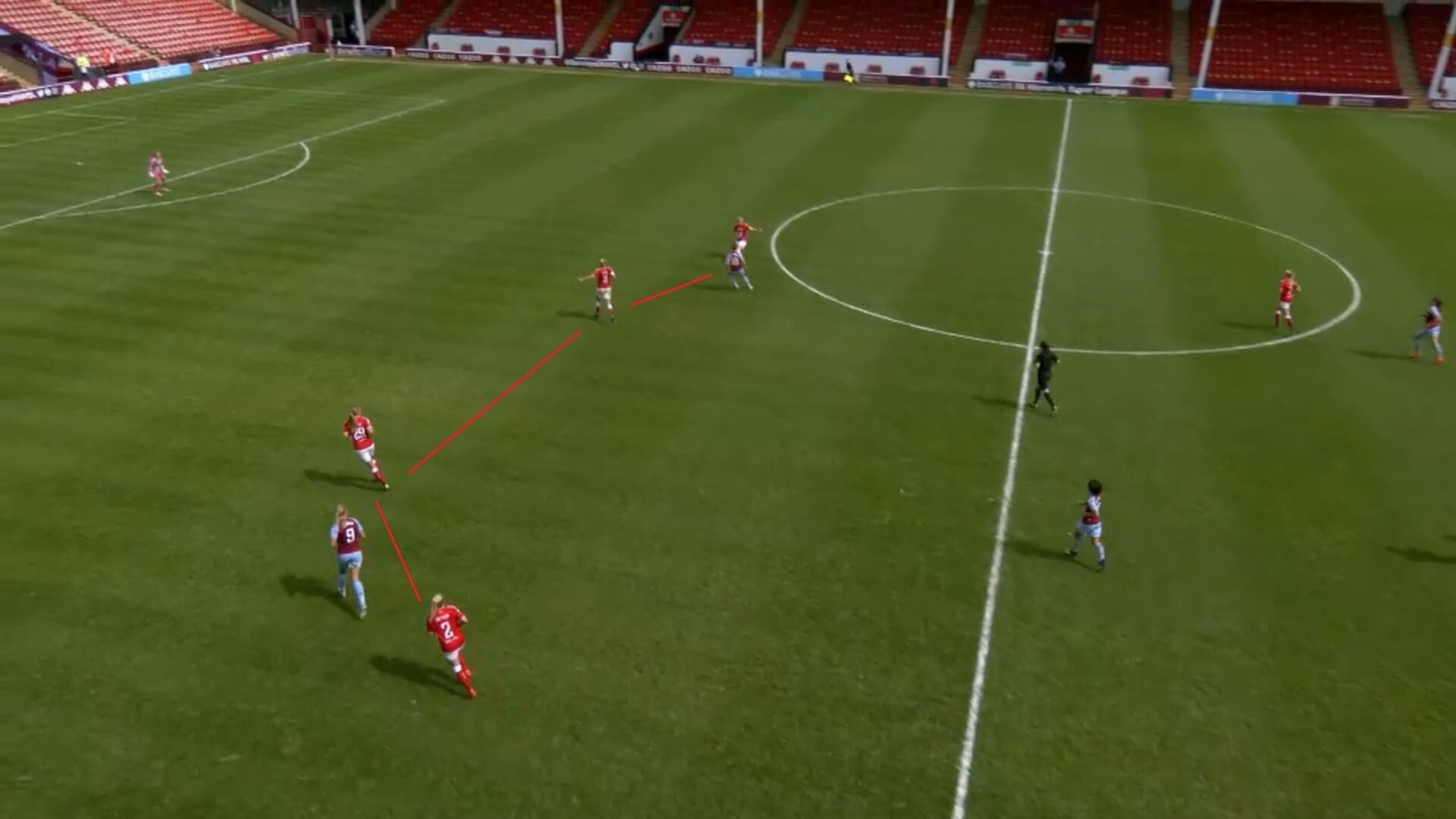
The key improvements came when Bristol made substitutions, which also altered things tactically for them. Right-back Faye Bryson replaced centre-back Meagan Sergeant for the last twenty minutes, with Bristol changing from a back five to a back four as a result.
Bryson’s introduction gave the away side more structure at the back, and better balance, with the substitute having the pace to get up the field and support attacks, as well as to track back when Aston Villa had the ball. Having a back four also meant that Bristol’s defence could move across the pitch as required, ensuring that, wherever Aston Villa looked to break through them, the defence could get there and stifle them, giving them minimal space to operate in. Therefore, this was a really positive change for Bristol, and gave them more strength at the back, which was a key reason that they managed to get back into this game.
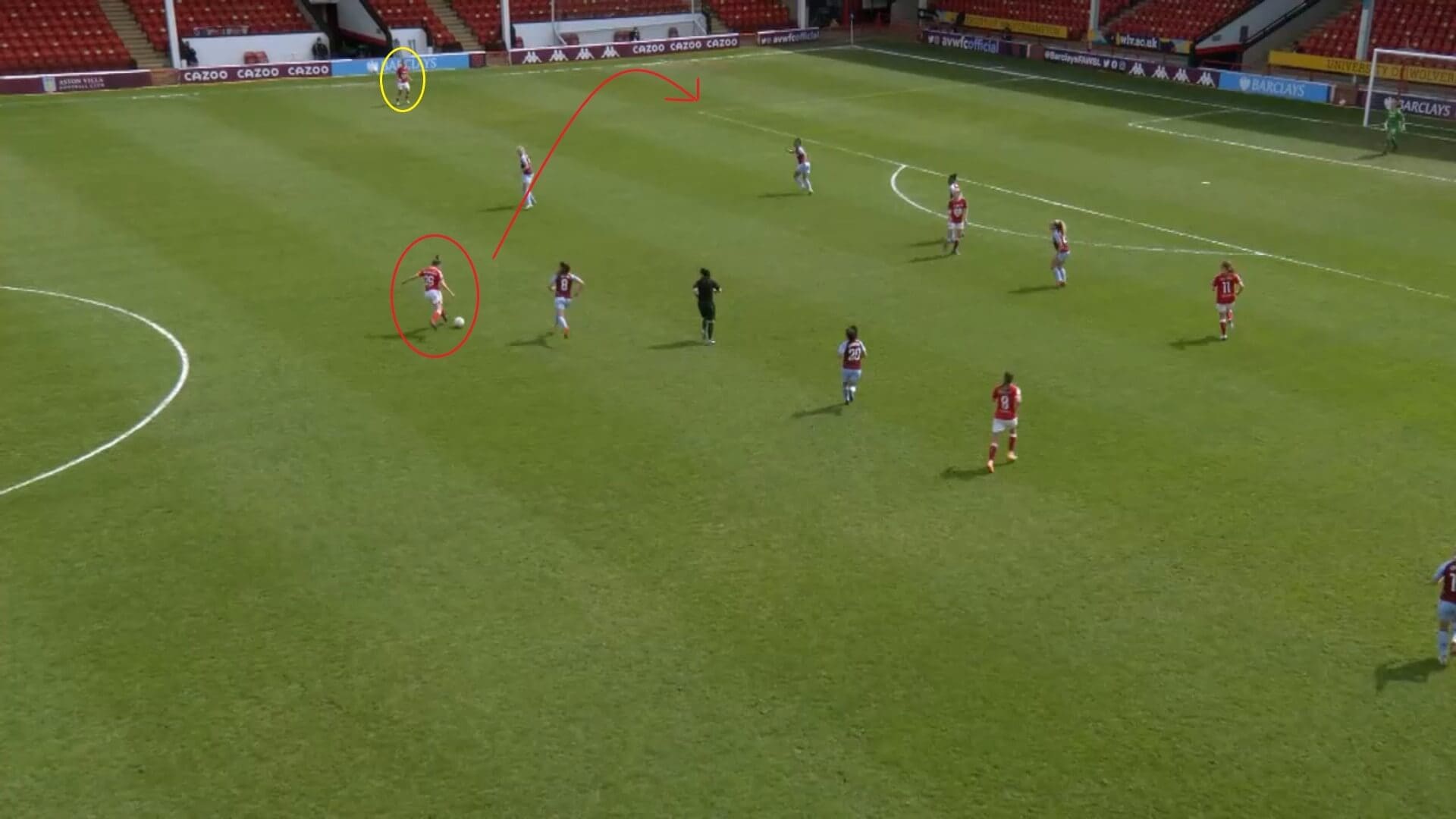
Their most effective change, though, came when Australia midfielder Ella Mastrantonio replaced Aimee Palmer in the midfield. Mastrantonio has good vision and an excellent passing range, able to pick out teammates from different areas around the pitch. Here, she has seen where the Aston Villa players are and where the space is, playing a long pass out to the wing for Daniels to chase down.
Mastrantonio’s introduction also gave Bristol’s midfield a new dimension, with her taking up the role of a deep-lying playmaker, allowing Pike and Humphrey to advance up the field more and assist the attacks. This gave their midfield a triangular look, with the Australia international sitting back and helping to move the ball around the pitch, creating more opportunities for those around and ahead of her. Mastrantonio also provided more cover for the defence, filling some of the gaps that we saw opened up in the first half by Aston Villa.
This was different to their first half play, which saw the three midfielders having to move from defence to attack and back again, not achieving much, so, again, this is a tactical change that worked for the away side.
Conclusion
In conclusion, we have looked in this analysis at the WSL relegation clash between Aston Villa Women and Bristol City Women. Whilst it was a game low on quality at times, both sides have earned another point on the possible road to safety, which is all that matters at this stage of the season. There is no doubting that Aston Villa will see it as two points dropped, given their 2-0 lead at half-time, but Bristol will be delighted to have not lost the game, knowing also that their performances need to improve if they are to successfully stay up this season. However, given Matt Beard’s comments that many have written his team off this season, he will be happy with their second-half resilience, never giving up, as that was what led to their late equalising goal to earn a precious point.
Aston Villa’s next game sees them travel to city rivals and fellow relegation candidates Birmingham City Women on Wednesday night. Bristol City Women, who have played a game more than Aston Villa and two more than Birmingham and West Ham, host Manchester United Women in their penultimate game of the season on Saturday afternoon.




Comments